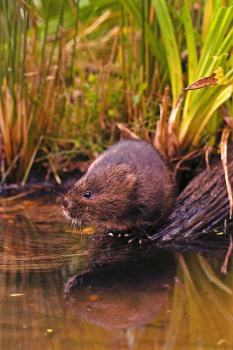Water voles, one of our most endearing and charismatic river inhabitants, have suffered a massive decline since the start of the 20th Century. However, a unique conservation project being launched by The Game Conservancy Trust aims to give the species a major boost by repopulating an entire river with more than 500 water voles this summer.
This science-based initiative marks the final stages of the £1.1 million River Monnow Project – one of the largest catchment scale river habitat restoration projects in the UK. Over 60km of river habitat improvement, including coppicing trees and bank-side fencing, has been carried out on four tributaries of the River Monnow (including the Dore) thus paving the way for the start of the water vole reintroductions later this summer.
Following on from the success of the restoration of the river, which is already reversing the declines of wild brown trout, grayling and other wildlife, this next important stage aims to form the blueprint for future water vole reintroductions across the country.
The Rural Development Service has funded the Monnow Project from the outset and is now providing £80,000 additional funding from Defra for the water vole reintroduction programme.
Roger Owen acting Regional Manager for the west Midlands said: “We are immensely impressed with the Monnow project; particularly the way the partnership has worked so tirelessly to restore the river to its former glory for the benefit of the local economy and wildlife. This next stage is addressing the needs of a Biodiversity Action Plan species and we are very much looking forward to seeing water voles populating the catchment again. Although this is a pilot project in the west Midlands,
we would very much like to see this type of work implemented across the country.”
Dr Jonathan Reynolds, leading the project for The Game Conservancy Trust said, “Water voles were once very common on the River Dore but like many other places in the UK they have completely disappeared in the past 20 years. Loss of suitable river habitat is one contributing factor; another major factor is predation by American mink, which is catastrophic for water voles.”
The successful reintroduction of water voles also depends on specific skills in captive breeding and release of the animals. This expertise, built up over 10 years, is being provided by the Derek Gow Consultancy, who are collaborating with The Game Conservancy Trust in the project.
Given the right conditions water voles breed very well in captivity and a good deal is already known about releasing techniques. However, this is the first time a self-supporting population has been re-created on such a large scale.
Prior to reintroducing the water voles, a crucial factor will be the removal of American mink from the river. Until recently, mink have proved difficult to control, mainly because they are often un-noticed until it is too late, but a novel device designed by the Trust – the GCT Mink Raft – has revolutionised the effective control of these voracious predators.
Once the mink are removed more than 50 separate colonies of water voles, amounting to 500 animals in total, will be released along 30km of river-bank this summer. Dr Reynolds said, “The aim is to re-build a population that is capable of surviving local flooding and other chance factors.”
Water voles, have suffered a drastic decline in range and abundance in Britain and nearly 70% of populations identified in a national survey in the late 1980s had been lost by the late 1990s. As a consequence, water voles are protected under the Wildlife and Countryside Act and are a Biodiversity Action Plan (BAP) species with a target of recovering their pre 1970s range by 2010. Despite these special protection measures water vole populations continue to be lost.
However, the future does look more promising for the species due to initiatives like the River Monnow Project. Dr Reynolds explains, “The significance of this project is both its large scale and the fact that for the first time we are addressing all the key factors that have contributed to the loss of water voles. Our experience on the Monnow will prove invaluable to other conservation agencies and an important aim of the project is to provide training and demonstration opportunities that will guide reintroduction programmes elsewhere in the future.”

Picture Copyright: Derek Middleton.
Water voles, one of our most endearing and charismatic river inhabitants, have suffered a massive decline but The Game Conservancy Trust aims to give the species a major boost by repopulating an entire river with more than 500 water voles this summer.








